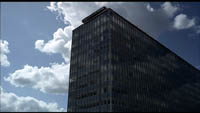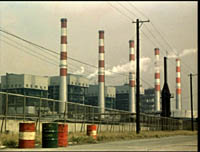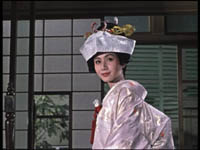Archive for the 'Directors: Weerasethakul' Category
First shots
DB here:
Over at the Scanners site, Jim Emerson is running a fascinating thread. He invites readers to write about their favorite first shots.
I haven’t joined in, largely because, as with all lists, I have too many favorites and I get tangled up in comparisons. What intrigues me is the idea behind Jim’s proposal.
We all accept that first shots are important. We often analyze films by comparing the beginning to the end, and I routinely ask my students to note the first and last shots of a movie we’ll discuss. But were first shots always as important as we now take them to be? The historian in me thinks that this is a fruitful question.
Consider the films most frequently listed on Sight and Sound magazine’s Ten Best lists from 1952 to 2002. All are classics. But can you recall the first shot of very many of them?
Battleship Potemkin, The Rules of the Game, Citizen Kane, L’Avventura, 8 1/2, The Passion of Joan of Arc, Vertigo, L’Atalante, The Bicycle Thief, The General, Greed, The Magnificent Ambersons, The Searchers, Singin’ in the Rain, Tokyo Story, 2001: A Space Odyssey, and Ugetsu Monogatari.
Now if you’re a keen fan of any of these, you doubtless know the first shots well. But for most of those you’ve seen but not fetishized, I have the hunch that the first shot may not be particularly memorable.
Yet what about the first shot of A Hard Day’s Night or The Conversation or The Player? You’re likely to recall those first shots after a single viewing, and they will stay with you. Nowadays we may even remember the first shots of certain movies that we don’t particularly like.
If you recall only one curtain-raiser on the Sight and Sound list, I suspect it will be that of 2001. As my friend said as we walked out of a Manhattan screening back in 1968, “The sun rises like you’ve never seen it before!” This makes me wonder if there’s a historical breaking point somewhere here.
Was there a moment when directors started to feel that they had to weight the first shot heavily, to treat it as a dense moment that the viewer should savor? The first shot of a film could be as vivid and bristling with implication as the first sentence of a novel. When might directors have begun to think along these lines? Did it start, like so much else in cinema, in the 1960s, and Kubrick entered the first-shot sweepstakes?
Historically, it seems that many first shots serve simply to set up the locale for the first scene. This might be the central function of opening shots inr many classics I just mentioned. No larger implications may hover around the first image.
Sometimes, though, the first shot cunningly plants a story element that seems unimportant at the moment but will become crucial later. My favorite example is the first shot of Harold Lloyd’s wonderful The Kid Brother (1927). (If you haven’t seen this film, go rent it immediately. Better yet, buy the box set, because everything on it is very fine; Lloyd is one of the great, underrated American filmmakers.)
Before I suggest a possible answer to the question of when first shots became attention-getters, here are some speculations about what such shots can do.
*The first shot can present a sort of Ultimate Cause, the basis for everything that follows. In The Birth of a Nation, the first shot shows black slaves brought to America from Africa.
*Sometimes the first shot, however brief, has emblematic significance. The first shot of Battleship Potemkin portrays waves breaking on shore, symbolizing the force of revolutionary consciousness. Eisenstein’s Ivan the Terrible starts with a shot of the tsar’s crown as the coronation is about to start: the whole film will be about the struggle for power. The “No Trespassing” sign at the start of Kane has been widely interpreted as urging us not to judge Kane too simplistically.
*Several of Jim’s contributors have pointed out how thematic elements get set up in an opening shot. Rules of the Game might be another instance: The long tracking shot that follows a radio cable plunges us into a world in which the naïve pilot is a celebrity, and it sets up a mechanical world (radio broadcast, the plane) that will be echoed in the Marquis’s music boxes later. In Play Time, it’s impossible to know what sort of building we see in the first shot–establishing not only the looming anonymity of modern architecture but the sort of games Tati intends to play with our perception. It also introduces the motif of reflections, an important source of the film’s themes of how old Paris has been spoiled by modern technology.
instance: The long tracking shot that follows a radio cable plunges us into a world in which the naïve pilot is a celebrity, and it sets up a mechanical world (radio broadcast, the plane) that will be echoed in the Marquis’s music boxes later. In Play Time, it’s impossible to know what sort of building we see in the first shot–establishing not only the looming anonymity of modern architecture but the sort of games Tati intends to play with our perception. It also introduces the motif of reflections, an important source of the film’s themes of how old Paris has been spoiled by modern technology.
*Likewise, the First Shot Project contributors have mentioned how the initial image can establish the film’s tone. A good example is the direct-address prologues of The Girl Can’t Help It and Will Success Spoil Rock Hunter? Another is the dissolve from the Paramount logo to the jungle mountaintop in Raiders of the Lost Ark, which signals the sort of tongue-in-cheek homage we’re about to get.
*Sometimes a fairly mundane initial shot becomes salient not in the film that follows but in the context of the director’s other works. In the case of The Passion of Joan of Arc, the book that is opened in the first shot links to all the other books that feature so prominently in Dreyer’s films. Long ago I argued that the book, and the act of writing in it, become important structural principles of how his films tell their stories.
*The first shot can set up a visual-design motif that will get developed in the course of the film. The most famous example is probably the opening door that starts The Searchers. As with Kane‘s “No Trespassing” this motif will serve to bookend the film, recurring not only at intervals but also in the very last shot. Ozu’s Autumn Afternoon opening–surely one of the greatest first shots in cinema–sets up red, white, and silver color elements that will be picked up in the daughter’s wedding dress at the climax.


Nowadays, many directors seem to think that they have to start the film with a dazzling long take with complicated camera movements. One example is De Palma’s Bonfire of the Vanities, which he seemed to try to top in Snake Eyes. P. T. Anderson goes all out for virtuoso camera movement at the start of Boogie Nights but then settles on a static long take for Punch-Drunk Love. As in the early sound era, a fancy opening shot can crop up in a more or less ordinary film too, such as the SkyCam- and CGI-driven introduction of the nightclub in The Birdcage. The convention of the flashy first shot is so widespread that The Player‘s opening can satirize it.
Actually, it isn’t that new an idea. Fairly far back in film history, directors seem to have realized that first shots should be freighted with implication. There probably isn’t only one moment when this strategy arises, but I’d suggest looking first at the period when synchronized sound comes in. Most films at the time were pretty static and theatrical in their reliance on dialogue, so a flashy opening shot or sequence could reassert “This is cinema.” The bravura tracking shot was a common way directors chose to draw the viewer into the film’s world, as at the start of Threepenny Opera or of Scarface. Maybe this is a key moment in which filmmakers began to realize that the opening shot of a film should grab or puzzle the viewer and let us reflect a little on the fact that it’s doing so.
Things that seem to us to be current innovations can go pretty far back. There’s a more general implication too. As critics and cinéphiles, we tend to notice particulars–this sequence, this film. But we can also study the history of film forms and styles. We can try to map out the broader principles and patterns, the sources and trends–the items on the menu, we might say–that shape filmmakers’ individual choices.
Movies that restore your faith in cinema, and audiences
David from Vancouver:
One of the pleasures of film festivals is the enthusiasm you pick up from the audiences. Queueing for a screening, you can talk with people about what they’ve seen or expect to see. This festival is so popular locally that some viewers take a week or two off work. Then sitting in the theatre and waiting for the show to start, you hear fascinating conversations. Last night, a young Taiwanese man (Frank) and a young Korean woman (Yuri) were sitting behind me and talked about what they were looking forward to, what they’d seen on DVD, how they came to Canada, and so on. Their love of cinema shone through plainly; somebody should make a movie about their lives.
People have every reason to be fired up about this festival. After five days here, I’m awash in fine movies. Besides the ones I’ve already noted, here are some standouts:
Opera Jawa: An ambitious reworking of an episode from the Ramayana, full of splendid imagery—everything from elaborate dance numbers to sudden appearances of shadow puppets. The soundtrack is equally lush, with gamelan mixing with more pop-flavored melodies, and the classic tale is intercut with current political struggles.
Monkey Warfare: A clear-eyed study of baby boomers stuck in late midlife, recalling their 1960s activism with both pride and guilt. It’s tough to make a movie with only three principal characters, but Reg Harkema pulls it off, blending comedy and drama and throwing in enough neo-Godardian flourishes to keep you off-balance. A very funny post-credits sequence. (But don’t Molotov cocktails also contain sand?)
The Magic Mirror: I tend to like about half of Manoel de Oliveira’s works, and I thought during the first forty-five minutes that this wouldn’t be one of them. Of course everything was filmed with his quiet majesty. (Advocates of the “clean image” furnished by HD should study what O’s films can squeeze out of Eastman stock: his etched, enameled images make every texture pop out at you.) But the early scenes feature rather repetitive dialogues about a wealthy woman who hopes to be granted a vision of the Virgin. I couldn’t see where all this was going and suspected that I was in the presence of what my friend J. J. Murphy, borrowing from Manny Farber, calls elephant art.
So I was squirming until a forger enters the scene with a plan to stage a vision for Mme Elfreda. Things get stranger and more elliptical, moving toward luminous glimpses of her final journey to Venice and Jerusalem. By the end I was completely won over by this grave, wise film. Now I have to go back and watch the beginning to see what I missed. You have to take these things on trust, especially from a director who’s lived nearly a hundred years.
Big Bang Love—Juvenile A: I’m not a big admirer of Miike Takeshi’s films, but I liked this better than most. Very stylized treatment of a young bully’s death in prison, with startling images and passages of brilliant cutting, and a landscape that haunts you. (Let’s just mention the pyramids and the rocket ship.)
Syndromes and a Century: A teasing, mesmerizing string of situations involving two doctors in a Thai hospital. Shot largely in long, distant takes, the film works out variations in its conversations among doctors, patients (including two Buddhist monks) and their lovers. Plot lines are sketched without being consummated, and the viewer is coaxed into imagining different futures for the people who drift into our ken. Apichatpong Weerasethakul, maker of Mysterious Object at Noon and Tropical Malady, has emerged as the major Thai director with his enigmatic and engrossing films. For those of you in the Midwest, take pride: He studied at the Film School of Chicago’s Art Institute.
Still Life: Jia Zhangke’s newest feature, crowned at Venice, has immediately become my favorite of his works. The city of Fengjie, being slowly demolished before it will be flooded by the immense Three Gorges Dam, becomes as vivid a presence as the theme park in The World. Day laborers take shelter in collapsing buildings, and prostitutes ply their trade in rooms with only three walls. One worker has come to town looking for his ex-wife; a woman has come from Shanghai seeking to divorce her husband.
The parallels aren’t forced, and the two stories are integrated by one of the most daring visual surprises I’ve seen in recent cinema. The stories are intimate, built out of small-scale encounters and daily routines, but they feel oddly epic too, as the hollowed-out city crumbles around the characters. In fewer than two hundred shots, many of them gliding along surfaces and faces, Jia presents a vision of humans obstinately seeking a better life. Shot on HD and projected on video, Still Life proves that digital filmmaking can evoke both thumping immediacy and poetic abstraction. (Keep your eye on the backgrounds.) It’s been acquired for Canada: What stateside distributor will pick it up?













